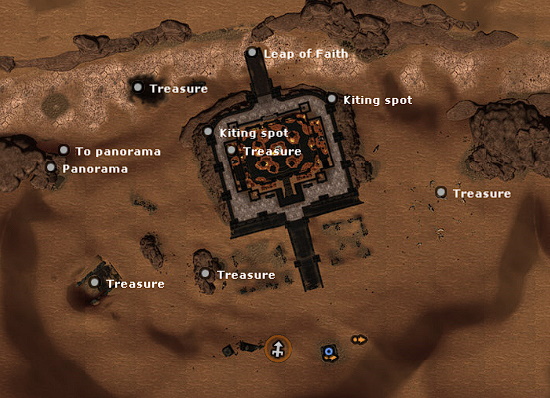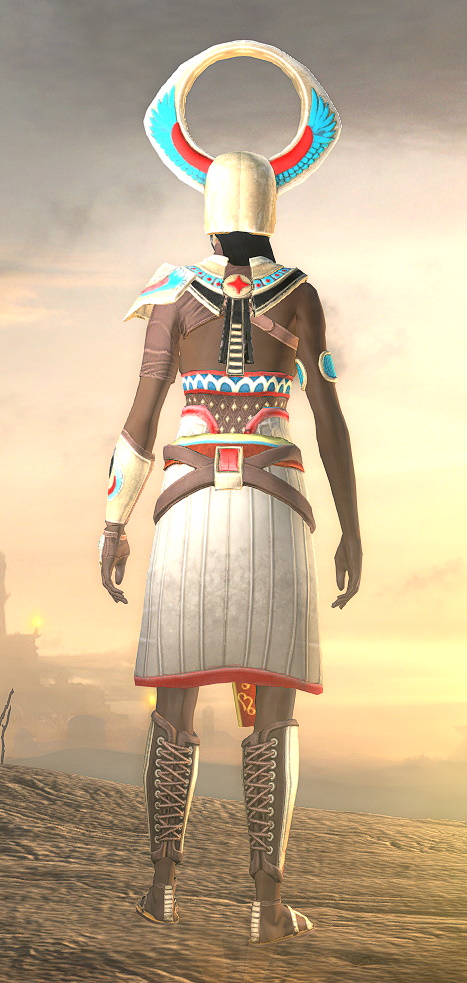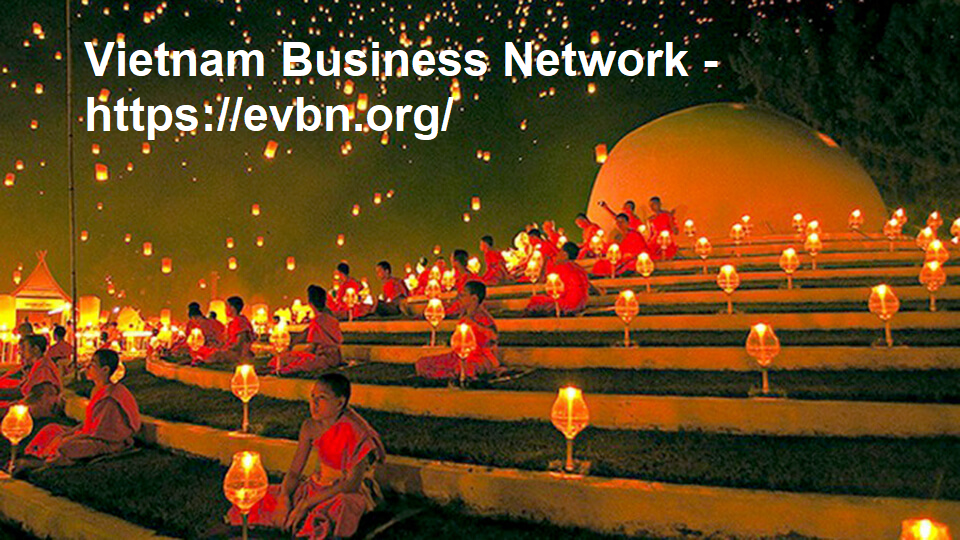cynara’s Age of Conan blog
When Funcom released the new Kuthchemes Onslaught content in late April,
they posted an unusually good and thorough forum
thread with an overview of the various mechanics, bosses, weapons, gems
etc. connected with this new game mode. Thus my present blog post will mostly
be about things that are not mentioned in that forum thread.
To begin with, here’s a map showing the locations of the treasure chests,
the leap of faith, and the panorama:

Mục Lục
Kuthcheman gems
These exist in rare (blue), epic (purple) and legendary (orange) variants.
The first two drop from wave 1 onwards, the legendary ones from wave 15.
Funcom’s forum thread says somewhere that gems have a higher chance of
dropping in higher waves; but I didn’t really get this impression in my farming.
There seems to be no great shortage of purple gems dropping on waves 1–5,
and you can perfectly well have long dry periods of no gems at all on waves 21–25.
But I haven’t collected any statistics about this, so I can’t be sure.
The stats on the gems are as follows (all numbers are given
in triples, corresponding to blue/purple/orange gems):
Kuthcheman Gem of Protection: 250/500/750 armor, 25/50/75 protection
Kuthcheman Gem of Wisdom: 5/10/15 wis, 20/40/60 hit rating
Kuthcheman Gem of Dexterity: 5/10/15 dex, 20/40/60 hit rating
Kuthcheman Gem of Intelligence: 5/10/15 int, 20/40/60 hit rating
Kuthcheman Gem of Strength: 5/10/15 str, 20/40/60 hit rating
Kuthcheman Gem of Constitution: 5/10/15 con, 20/40/60 hit rating
The protection gem is probably the most attractive of these,
especially when combined with the tank shield (which has a lot of armor by itself).
The constitution gem is a worthless joke. The others are OK if not particularly
exciting.
I was unusually lucky with the protection gems. The first time I saw
a legendary protection gem drop, I won it with a need(100) roll 🙂
So far I don’t think I’ve seen more than four or five of them drop, after doing
a little over 1900 waves at wave 15 or higher.
Onslaught gems
I seem to remember than on very rare occasions, these gems can drop from
(mini)bosses in Kuthchemes, but for the most part you’ll have to buy pouches
from the vendor in front of the Old Tarantia library; when you open a pouch,
you get a random Onslaught gem whose rarity (blue, purple, orange) matches
that of the pouch.
These gems have names of the form X Onslaught Gem [of Y]. Such a gem
has one stat depending on X, plus T6 buffs depending on Y:
If X = Fatal, the gem has 120 (if blue/purple) or 240 (if orange)
fatality rating.
If X = Ferocious, it has 20 (if blue/purple) or 40 (if orange) ferocity.
Y = one T6 blessing if purple, two if orange; none if blue.
Thus many Onslaught gems are fairly unattractive due to strange
combinations of T6 blessings, or because they are fatal while most people
want ferocious ones. On the other hand, a few of the most attractive
ones (mostly legendary ferocious gems with Ashur + another blessing) have been
known to sell for ungodly amounts of money.
On the whole I think it’s a great idea that Funcom made all the new
gems tradable; previously trading was getting a bit moribund since
there wasn’t much to trade; all the good gear was bind-on-pickup
(and Funcom hadn’t updated crafting since 2008 or so). I guess this is
why these new gems fetch such high prices; there’s a good deal of money
in the game but nothing else to spend it on. I myself made more than
11k gold selling gems, and I know I’m far from the biggest profiteer
in this area.

I’d be glad to spend some of this money on some good gems, but sadly
you rarely see them for sale on the trader.
Kuthcheman weapons
The new vendor sells weapons for all classes, costing 2000 relics for
one-handed and 4000 relics for two-handed ones. They are mostly very similar
to T6 weapons in terms of stats, often even a little better, and they
get better still once you put gems in them. The weapons don’t have any
T6 blessings, so you have to put in an Onslaught gem to get those.*
[*I wonder if the assassins are at a bit of a disadvantage here; their T6 main-hand dagger has
two blessings and the T6 offhand dagger has one, and all three of them
actually count; but here, the Kuthchemes main-hand dagger has an Onslaught
gem slot (where the gem can provide you with two blessings) while the
Kuthchemes offhand dagger has no Onslaught gem slot, so you get a total
of two blessings from your weapons rather than three as with T6 weapons.]
In addition to the usual stats, the Kuthchemes weapons also have
ferocity; 100 on one-handed and 200 on the two-handed ones. With all
this ferocity, my guardian’s Cry of Havoc now hits 6 targets instead
of 4 — rawr, I’m so OP now 😛 I think that ferocity benefits casters
more than melee classes; e.g. on a ToS, the range of your storm field
increases and you can hit 7 instead of 5 enemies with it, and since
it’s your main damage-dealing spell this is quite a substantial improvement.
The regular Kuthchemes weapons you buy for relics from the vendor are bind-on-pickup,
but there is also another set of gilded Kuthchemes weapons, which are bind-on-equip. These
drop from Onslaught Treasure Chests, which you can buy in the item shop.
I bought five of them and got no weapons, which I guess shouldn’t be surprising as
the drop rate is probably a good deal lower than that.
The gilded weapons have exactly the
same names (except for the “Gilded” prefix) and stats as the corresponding
regular weapons, and they also use the same models, but they tend to be coloured in
reddish tones rather than bluish ones.
I was quite content with the regular ones, and e.g. the bluish shield looks
very well on my guardian, with her blue dress, blue hair and blue horse 🙂
But I know at least one player who took the trouble to get a Gilded shield for
his ToS because it went better with the red robe he wears as vanity armor.
The tank shield (Kuthcheman Tower Shield) has particularly nice stats, having much more
armor than any other shield I know of (1858 armor, plus 120 armor from strength); not to mention that it has a Kutcheman
gem slot, where you can put a legendary gem with 750 armor (and 75 protection).
This brings you to a total of 2728 armor. By contrast, the T6 tank shield has
968 armor plus 164 armor from strength, for a total of 1132 armor.

Kuthcheman War Blade

Kuthcheman Tower Shield
Kuthcheman pets
The new vendor also sells three purple pets, costing 650 relics
each: the Kushite Chieftain, Prince Kutamun and the Khorajan Sandwyrm.
The pets look nice, but a minor disappointment is that they don’t do
anything interesting; they just stand there. The Khorajan Sandwyrm is
a large snake; the Kushite Chieftain is a smallish rhino with an even smaller
rider; and Prince Kutamun is tiny, riding the horse the size of a dog.

Kushite Chieftain

Prince Kuthamun

Khorajan Sandwyrm
I was pleasantly surprised to see that Funcom also added fights for these pets
to the Pit Master’s Arena in the Field of the Dead, as they often tend to
forget this when adding new pets to the game.
Now, the amount of HP that a pet has when you fight it in that arena normally
depends on its rarity: white pets have about 14k HP, green ones have 25k,
blue ones 44k, purple ones 59k and orange ones 81k. But surprisingly, two of the new pets,
the Kushite Chieftain and Prince Kuthamun, have 119k HP, twice the amount you’d
expect for a purple pet.
The Kushite Chieftain fight was easy enough anyway. He has an ability
called Star Fall, at the end of which cast he spawns a few circles on the
ground and it probably makes sense to stay out of them to avoid taking damage.
There is a ranged holy attack called Judgment, which you can CC. Apart from
that it was just a tank and spank fight.
The Prince Kuthamun fight, however, was very difficult for me on my guardian.
He hits relatively hard; if I try to just tank and spank him, I will either die
from the incoming damage (if I do it in frenzy) or run out of time (if I do it
in normal or defensive stance). The only way I could do it was by going
frenzy (and also equipping heavy armor, DPS-oriented accessories, using a DPS-oriented
build, the Prime Initiative perk for an extra CC, etc.) and taking care to avoid some
of the incoming damage by CCing and kiting. He has two important abilities:
• I Shall Not Be Beaten gives him a damage buff for about 10 seconds.
You can CC him while he’s casting this to prevent him from getting the buff.
He doesn’t turn while casting it, so you also use the opportunity to go around him
and land a combo on an unshielded side meanwhile. A good finisher on his back
has a chance of knocking him off his horse, not that this seems to change the
rest of the fight in any substantial way.
• Aura of the Dreadnought gives him two buffs. One lasts a shorter time
and makes him completely immune to damage, but also snares him, so you should kite
him during that time to avoid taking damage unnecessarily. The other buff lasts a bit
longer and simply increases his mitigation. He can’t be interrupted while casting Aura.
I found the Momentum stun useful, both as a chance of interrupting his casts
and also to reduce the overall damage he does, because he hits pretty hard if
you’re in frenzy stance. Even so, I just barely survived and just barely killed
him within the 3-minute time limit. Here’s a video of the fight:
I wonder what it’s like on other characters, but I haven’t farmed the arena on
any of my alts so none of them is at the point where they could fight a purple
pet at all.
The third pet, Khorajan Sandwyrm, has the normal amount of HP and
there’s nothing unusual or particularly challenging about fighting it in the arena;
it’s a simple tank and spank fight.
Some general advice on doing Kuthchemes Onslaught
In the first month or so after Kuthchemes was released, it seemed to be pretty
popular, lots of people were doing it both in private groups and via the raid finder,
and the latter was popping even at higher waves. But after that, I was saddened to
see how quickly most people lost interest in it, usually after getting enough relics
to buy the weapons they needed. They seemed to have little interest in continuing
to farm for gems, let alone for social gear. In the raid finder, there were so
few competent players left signing up that doing anything higher than waves 1–5
became too risky, as most of the time the group would wipe without getting anything
done. Most people, if they kept on doing Kuthchemes at all, did waves 1–5 for
the daily quest and were content to accumulate relics gradually in this way.
So I thought I’d post some advice here based on my experience with farming
slightly higher waves, though I doubt it will be of much use; those who are interested
in farming higher waves already know these things, and those who aren’t will have
no use for them.
• At lower waves, people usually run around as a group from one
wildlife camp to another to clear them for some additional relics, and they
fight the incoming waves of mobs wherever they happen to encounter them. At higher
waves, say from 15 onwards, this gets more and more risky; if you encounter a
large wave of mobs in the open, you can’t bunch them up easily (especially if
many of them are ranged, as often happens), so you can’t kill them quickly and
the tanks also can’t keep them aggroed if they are scattered all over the place,
so they’ll start killing the squishies.
Instead, at that point it’s common for the group to stay close to the temple
entrance nearly all the time, waiting for the mobs to come to you. They go for
soldiers in defensive stance by default, so the tank can use line-of-sight to
control where they go and to bunch them up more easily. Various corners of the
temple are useful for that, and the top of the two stairways leading to
the temple from the sides is particularly useful. If the mobs are coming
from above (from the sides of the temple), stand on the stairs a little
below the top, so that they can’t hit you at range and have to run to the
top of the stairs. If, on the other hand, the mobs are coming from below,
stay on the level floor between the stairway and the temple wall, so that
the mobs have to come all the way to the top of the stairs before they can
hit you. This way you can keep them bunched up relatively easily, and you
can DPS them more efficiently.
• From say wave 15 onwards, and even more so from 20 onwards, I’ve found
it very useful to have someone on discord calling when to go where, to keep the
group together. Letting people run around individually is a surefire way to get
them killed, which usually leads to a downward spiral and a wipe.
When you get the on-screen message about the boss casting a noxious
spell, this is the sign that green clouds of poisonous gas will soon spawn
on the location where randomly chosen players are standing. It’s useful if
people run away from the tops of the stairways at that point
(e.g. go towards the middle, in front of the temple gate itself) , so that the
clouds won’t spawn there and you can go back there after the clouds stopped
spawning. There are three clouds normally, but from wave 28 or so there
seem to be four — count them so you know when it’s safe to return to
your normal positions.
• If you see a skull miniboss running towards the temple entrance,
you should have someone charge it; that makes the miniboss stop there instead
of continuing his or her way inside the temple. Fighting it inside the temple
is risky because its gets very crowded and the waves of trashmobs might block
your way out. Some other CCs might also work instead of charging, but not
all of them; sometimes I’ve seen the miniboss continue its way after the CC wore off.
• There are two useful kiting spots on the north-west and north-east
corners of the temple wall. You can easily jump, almost walk, from the platform on the
inside of the wall to the rocks on the outside and back; but the mobs can’t jump there
and will instead have to take a detour. This can be extremely useful, e.g. to kite
a boss while the rest of the group deals with any remaining skulls and trashmobs, etc.

You can jump as shown by the red arrow, but the mobs will have to run around as shown by the green arrow.
• Since the update that added Skull Gate Pass to the game, you can
use self-rez potions not only there but in Kuthchemes as well, which is highly advisable.
I recommend the ones you buy with Rare Trophies, from the Trader of Fortunes vendors
in Fengdu (Kara Korum) or Heaven’s Lake (Paikang); these have no cooldown, so you can eat them like
candy from a stranger’s van 😛
Similarly, you can spawn pets there, and many people like to use e.g. the Rocknose
pet, which has a chance of interrupting the enemy’s casts; or a Kappa pet, which
can give you various buffs.
• Some thoughts on the group setup for higher waves. The main thing
is to have enough AoE damage to deal with the waves of trash. A good demo is pretty
much indispensable due to their Wave of Flames spell. It isn’t necessary
to have more than one tank, but it’s very advisable to have two healers so that
in case one dies, the other one can still rez people (Acheronian Deathcharms,
which you can buy from one of the vendors in your guild city tradepost, can also
be useful here, as they enable non-healers to also rez people in case of emergency).
Having both a PoM and a pet necro is a very useful combination because you can use
Holy Cleansing to quickly clear a wave when you start getting overwhelmed.
Of the soldiers, a conqueror is attractive due to the nearly constant knockbacks,
which make it much easier for squishies to stay alive; on the other hand, it is
impossible to fatality a mob while it’s knocked back, so the meter will fill up more slowly.
The two groups that reached wave 40 so far had the following setups:
one had a conq, 2 PoMs, 2 demos and a necro; the other had a DT, PoM, ToS, HoX, demo, necro.
Spawning the champion; fatalities
At higher waves, people generally don’t care much about farming
the wildlife camps, because the amount of relics you get from them remains
constant (2 relics per camp, or 3 if with the subscriber bonus), but the
HP of the mobs there keeps growing and so does the time to farm them.
Your main interest at higher waves is in spawning the champion (i.e. the end-of-wave
boss), because it is he that drops the gems and social armor pieces, as well
as an increasingly large amount of relics: at waves 1–9, the champion
drops 5 relics (8 with the subscriber bonus); at waves 10–14, it
drops 10 (15 with the s.b.); at waves 15–19, it drops 15 (23 with the s.b.);
at 20–24, it drops 20 (30 with the s.b.); and from 25 onwards, it drops
25 (38 with the subscriber bonus). The highest wave at which I killed the champion
was 38 and it still dropped 25 (38 with the s.b.) relics there.
The champion spawns if you fill the meter before killing all the mobs of that
wave (wildlife camp mobs don’t count as mobs of the wave for this purpose);
the meter fills from doing fatalities and, if I’m not mistaken, also from doing
kill streaks. Towards the end of the wave, if the meter isn’t full yet,
it’s useful to keep some mob alive and kite it — the guardian skull-bosses
are very suitable for that, since they are very slow (until you DPS them below
50% to lose their shield) and thus easy to kite. While shielded, the guardian has
a very high chance of resisting spells, so you can have a necro put some melee pets
on it to get its attention; and keep it
away from where you’re fighting so it doesn’t lose its shield (and start running
annoyingly quickly) from splash damage.
Then, when you’re done fighting the wave except for that one mob you’re
keeping alive and kiting, you can try to fill the meter by doing fatalities on the
mobs from the wildlife camps. Since you have a limited number of mobs there and
have to do enough fatalities to fill the meter, it is in your interest to avoid
killing those mobs without fatalities. Thus, you can’t use magical attacks on
them, because there the mob will take damage from the attack regardless of whether
it triggers a fatality or not. Instead, you have to use finishers of melee combos.
Once the mob is at sufficiently low health (low enough that the combo finisher has
a decent chance of killing it), the melee character should deliberately miss the
white hits of the combo and then land the finisher, but interrupt it by moving
or jumping as soon as the finisher starts. Now, when the finisher starts, the
server calculates its damage; if this would be sufficient to kill the mob, the
server then does a random roll to decide if it will trigger a fatality; and if it
does trigger a fatality, your melee character gets locked into the fatality animation
and cannot interrupt the finisher.*
[*This isn’t quite true. Sometimes it happens that the fatality animation
starts, but gets interrupted anyway; I suspect this has something to do with lag
and with the server and client briefly having different ideas as to what happened.
In any case, if this happens the mob still won’t have taken any damage, so there’s
no harm and you can keep trying.]
On the other hand, if the server decided there
will be no fatality this time, it lets you interrupt the finisher, and if you have
interrupted it before any of the hits that constitute the finisher actually happened,
the mob will have taken no damage and the combo won’t even go on cooldown.
A popular combo for these purposes is good old Slam, which doesn’t require any
white hits before the finisher and where the finisher consists of a single hit
that comes at the end of the animation, so you have enough time to cancel it.
To make sure that you have enough mobs left at the end of the wave
in case you need to do fatalities, it makes sense to avoid killing any mobs
from the wildlife camps during the wave itself; and thus to be careful not to
pull them while e.g. fighting some skull miniboss that might have positioned
himself nearby. Another popular technique is to leave the treasure chest mob
alive after clearing a wildlife camp. This mob doesn’t despawn, but remains
alive indefinitely, so you can keep it around in case you need something more to
fatality at some later point. The only risk here is that if you wipe, you won’t
get the chance to kill any remaining treasure chest mobs and loot the 2 or 3 relics
that each of them drops upon being killed.
The special enemies
This is what Funcom’s forum thread calls them; I like to think of them
as skull minibosses because they are marked with a skull on the map. The
thread gives a good overview of their abilities.
Of the four types of special enemies, the witches should probably have the
highest priority to be killed, because their debuffs can drain your mana and stamina,
snare you, reduce the AoE of your spells and reduce the power of incoming heals
— a sure way of making the whole group completely ineffective. The witch
can also be CCed with everything except fear.
The concubines spawn clouds, which are annoying but as long as you stay out of them
(to avoid the damage and stun at the end just before the cloud disappears) they are not too bad.
The cloud gets thicker over time, which gives you a hint when it’s really time to get out.
The spell whereby she spawns clouds is called Roiling Storm and the damage (and stun)
come at the end of the spell. If you kill her during the spell, the cloud will stay but
won’t do damage or stun you at the end.
The concubine also causes each player to do some electrical damage to other nearby players
(Echoing Lightning), which can be painful at higher waves. Try not to stay too
close together. Unlike the witch, the concubine can’t be CCed.
The excavator spawns groups of trashmobs which aren’t particularly
dangerous at first, but they explode upon being killed, which can get quite painful
at higher levels. Besides, the longer the excavator remains alive, the more trashmobs
he spawns each time he completes his spell. You can keep an excavator alive some
time to help fill the meter (thanks to the extra trashmobs you’ll get from him),
but be careful to not get overwhelmed.
The excavator can be CC’ed to interrupt his summoning spell and force him
to start from scratch. Even a guardian using his momentum stun and his other CCs
can completely prevent the excavator from spawning any trashmobs for as long as he likes.
Guardian skull-minibosses are the least trouble. Initially the guardian
has a shield that gives him a high immunity but also snares him, so he’s easy to kite.
His immunity also means he has a high chance of resisting things like irritate and goad,
so be careful if he runs in the middle of your group hitting the casters — the
tanks can’t grab him as easily as they could if it weren’t for the shield.
Once you DPS him below 50%, he loses his shield (and doesn’t regain it later even if
you let him heal up), at which point he’s hard to kite but also easy to kill and
to tank.
Guardians come in two varieties: one has a sword and shield, one has a two-handed
weapon. The latter, if he can’t reach the player who has aggro on him, will switch to
a crossbow and use ranged attacks; the former, however, will just stand still and helplessly
try to switch his weapons without actually doing anything.
This makes the sword-and-shield guardian easier to deal with; a caster can grab aggro and
then stand on one of the little raised square platforms (merlons?) on the outer side
of the temple walls. The guardian won’t be able to reach him with melee attacks there
and, being too incompetetent to do a ranged attack, will just stand there and do nothing.

A sword-and-shield guardian unable to reach my necro while she stands on the platform. (Click to enlarge.)
All types of special enemies frequently get pretty strong heals, which you can’t
prevent them from getting, but a rogue can remove them with Taintead Weapons. This is
probably the only reason why you might want to have a rogue in the group, as otherwise
their poor AoE damage makes them distinctly less preferable to casters. Somewhere
until wave 20 or so, you can have a single rogue running around on his own killing
the special enemies while the rest of the group stays by the temple entrance, killing
the waves of mobs that come there.
This plan gradually gets more and more risky because the rogue is also at risk
of dying. If several special enemies spawn together, the damage from them might kill
him; if one of the special enemies is an excavator, the trashmobs he summons might
kill the rogue; and if any Mana Hungerers (hyena-like mobs) spawn there, they might
go for the rogue because no mana user is nearby (normally they lock their aggro on a
mana user, but will take a non-mana user if there are no mana users near enough),
and kill him.
Thus at really high waves the rogue is probably more of a liability than an asset.
The leaderboards currently show that no barbarian has reached a wave above 30,
no assassin over 27 and no ranger over 25. At that point you probably want to
avoid having a rogue in your group, and you can send two casters, or even the
whole group, to kill special enemies. Just make sure to clear any current
waves of trashmobs before leaving the temple entrance and moving to where the
skull miniboss stands.
The champions
“Champions” is what Funcom’s forum thread calls the end-of-wave bosses that
spawn if you filled the meter. In each wave, the mobs spawn for 200 seconds; after that,
no new mobs will spawn (except if you have excavators alive; they will of course keep
spawning trashmbos). If the meter
fills during those first 200 seconds, the boss will spawn immediately when the 200 seconds
are over; if the meter fills later (but before you have killed all the remaining
mobs and thus finished the wave), the boss will spawn immediately when the meter
fills. The boss, like other mobs, will generally go for a soldier in defensive
stance, but if no such character is nearby, the boss will go for whoever is closest.
Use this information to avoid getting surprised by a boss. Running a script
that shows the time in group chat is helpful here.
People who mostly do lower waves are perhaps not used to paying much attention
to the mechanics of the boss fights, so here’s some advice that might be useful
at higher waves:
Kushite Chieftain
This is the rhino boss that you encounter at waves 1–4 and again at 20–24.
The most important ability to watch out for is Earthquake, at which point he
knockbacks the aggro holder and charges the most distant player or pet. He also seems to get
a temporary amount of hate towards the charged target, so that he’ll do one or two hits on it
and quite possibly kill it. Keeping some ranged pet at a suitable place to attract the
charges can be useful, though in my experience it isn’t 100% reliable that he will in fact
charge a ranged pet rather than a player (even if the pet is farther away).
The tank can help a lot with controlling the charge and the knockback by
running away while the boss is casting Earthquake. If other players are close enough,
you can be the farthest by the time the cast is finished, so that the boss will charge you
instead of the squishies. You can use doubletap at that point to avoid getting knockbacked.
Other players should help by making sure they hug the boss while he’s doing
Earthquake. If you’re kiting e.g. a Guardian skull miniboss, run to the boss anyway
and then run away again so the Guardian doesn’t get caught in the splash damage and cause trouble.
The Earthquake ability has a fairly short cast time, so you have to be ready
and react quickly. It seems to be on a timer, and usually comes immediately
after his Savage Healing cast, except the first one, where there are usually
one or two melee attacks between Savage Healing and Earthquake. However,
if you kite the boss, the timers of these different abilities can get confused and
you shouldn’t rely on them coming in this sequence.
This boss has a pretty strong self-heal, so if you have a rogue in the group,
he can remove the heals and the fight will be much shorter. This also means that
you can’t afford to kite the boss much during the fight or he’ll heal up. He hits
pretty hard, and it’s all physical damage.
Presumably this boss would appear again at wave 40, but I don’t think
anyone has actually seen it. My understanding is that the two groups that cleared
wave 40 didn’t get the boss there and then wiped on wave 41 before reaching the boss.
Attendant of Zug
This is a giant shrimp similar to e.g. Leviathus in the Black Ring Citadel;
you encounter it on waves 5–9 and again at 25–29. This boss does magical
damage and also hits pretty hard, but as long as the tank wears protection gear, it’s
a simple tank and spank fight. It is also slow and thus very easy to kite, should
you want to do so. From time to time it spawns two adds (Creeping Cold) that do relatively
heavy physical damage, but they have very low HP so they should be easy to kill quickly
(or indeed should die from splash damage).
In fact, when it comes to waves 25–29, the difficult part is not
the boss but the trashmobs during the wave, because you get large numbers of
ranged mobs (mostly horse archers, but also some casters) and it can be
difficult to bunch them up well enough and kill them before they start killing
the squishies in your group.
Prince Kutamun
This is a warrior on a horse that you encounter in waves 10–14 and
30–34. Every few seconds he drops pools of fire on the ground, which
gradually grow larger and eventually disappear. Anyone standing in the fire takes
damage, of course. Thus the tank should move the boss every couple of combos
to avoid standing in the fire. Besides this fire damage, the boss does
physical damage (slashing and sometimes piercing) on the aggro holder, and occasionally
there’s also an unholy proc (Unholy Touch).
I have very limited experience with this boss in its higher-level incarnation,
but it seems that he has been considerably overtuned there and basically hits
so hard that trying to tank it is next to impossible in the long run.
In one group I was in, a DT tanked it for a short time while being healed
by a PoM and a ToS, the other three members being mages (demo, necro and HoX),
and the group had a very high damage output so the fight didn’t last long.
That, I guess, is one way to do it.
The other way is by kiting, which is what
we used when I was dealing with this boss on my guardian. Unlike the rhino boss,
Kutamun doesn’t heal up. You can have the tank build some
aggro by doing irritate and maybe a combo, then use the kiting spots by the
northern corners of the temple while other people stay on one of the square
platforms on the wall and slowly DPS the boss from range. The tank can try to hit the
boss a bit now and then, to keep aggro more easily, as long as he doesn’t get himself
killed by the insane amounts of incoming damage.
Sooner or later, someone will pull aggro anyway and most probably die.
The tank, at that point, should take the boss to the opposite corner of the
temple and kite him on the kiting spot there, while one of the healers resurrects
the dead player(s). You might want to keep one healer at a safe distance and
completely uninvolved in the fight (apart from the rezzing) so that you never
get into a position where both of your healers would be dead. It’s a slow, but
steady and reasonably safe way to do it.
Thugra Khotan
This is the magician boss that you encounter on waves 15–19 and again
at 35–39. I’ve only done waves 35–39 once, and I was on my necro
then, so I can’t say much about the high-wave version of the fight except that
the way we fought him didn’t seem different in any substantial way from the
low-wave version.
The boss has two main abilities to watch out for. During
Ignite the Earth, he targets a random player and at the end of the casts
he spawns a circle on the ground where that player stood; this circle does fire
damage to anyone standing in side it. Thus, the targeted player should run away
from the others during the cast, so as not to spawn the circle at an inconvenient
location. Fighting near one of the corners of the temple can be useful for this
purpose, as the targeted player can then simply break line-of-sight by going
around the corner. If a circle nevertheless spawns on the boss, the tank will
simply have to move him.
The other ability is Sever Souls, which spawns floating skulls at the locations
where players and their pets stood. A few seconds later, these skulls explode,
doing a lot of AoE damage and stunning players. You should prevent this by
killing the skulls before this happens. Some of the skulls may be at range
(e.g. due to the presence of ranged pets), so make sure to look around so as not
to miss any.
During the fight, the boss also spawns adds — trashmobs of the same
kind that you also see during the wave. They run for the tank, as usual,
and the melee ones will easily die in the splash damage. The ranged ones,
however, may be content to stay at range and hit the tank from there.
Thus other players should take the trouble to aggro these and kill them,
so that the tank doesn’t have to put up with damage from these adds in addition
to what he gets from the boss.
Social armor
Besides gems, the main allure for me of farming Kuthchemes Onslaught was
the social armor set, Kuthchemes Sorcerer-King, which drops from champions
(end-of-wave bosses) at waves 20 and above. It consists of 9 pieces (all 8 usual armor
pieces plus a necklace):

Stygian priestesses gone wild!

Collecting this set probably took more farming than any set I’ve collected
in Age of Conan so far. Like other drops in Onslaught mode, this armor is bind-on-equip,
so it can be traded between players. If this game still had a healthy population
of players able and willing to farm higher onslaught waves, we might see a decently
liquid market emerge and completing a set might not be so difficult; but as it is,
the main problem is simply that very few of these items come into existence because
so few people farm those waves. Many thanks to my fellow farmers, especially those
who traded items with me to help me complete my set. It would not have been
possible without you ❤
I was wondering which character to equip the set on. It looks like
something much more suitable for a caster and a Stygian; my main is a
guardian and a Cimmerian, so this set wouldn’t look good on her; besides,
I didn’t want to give up my blue Aquilonian dress there. So I decided that
I would equip the Kuthchemes Sorcerer-King set on my ToS once I collected all
the pieces. Now that I’ve done so, I can’t help feeling that the set doesn’t
look quite as good on my ToS as I hoped it would when I started collecting it
all those many months ago.
The headpiece covers my character’s face, which I
always dislike in headpieces; besides, its face-mask looks like a man’s face
complete with a pharaonic beard, and I don’t think it looks terribly good on a
female character. But on the other hand, to hide the headpiece means to be
deprived of the beautiful basketball hoop at the top, which is surely one of the most striking
features of the whole set.
The chestpiece is perhaps the skimpiest, sluttiest chestpiece I’ve yet seen in this game,
leaving *both* of your tits completely exposed. The fabric you see below the tits
is actually a part of the leg piece! The “chest”-piece mostly covers your left
shoulder and a bit of the upper arm. Its colour happens to almost perfectly
match my ToS’s skin (IIRC that’s the darkest shade of Stygian skin colour),
which makes the chestpiece barely visible. It might look better on a lighter-skinned
Stygian; perhaps I should have equipped it on my necromancer, but then I didn’t
want to abandon her innocent-looking white robes 🙂
Apart from that, the set is really quite nice-looking. I particularly
like the contrast between red and turquoise areas. I was a bit surprised that
the wrists and hands are so asymmetric, being present only on your left hand,
but maybe the idea is that you carry a shield in your right one. But if that
was the plan, unfortunately my ToS mostly uses a staff.
Drop rate of the social armor
Doing 1091 waves at wave 20 or higher, I saw pieces of social armor
drop 40 times (4 legs, 4 necklaces, 4 hands, 3 belts, 3 chests, 6 shoulders,
7 bracers, 7 heads, 2 feet); thus the chance of a piece of social armor dropping
seem to be about 3.66%, or about 1 in 27. [You might say that it doesn’t make
any sense to estimate the drop rate this way; the denominator should be the
number of champion kills, not the number of waves done, because if you do
the wave without spawning (and killing) the champion, you certainly won’t get
any social armor. Unfortunately I wasn’t keeping track of my champion kills;
but since we farmed waves 21+ specifically for the sake of gems and social armor,
i.e. things that drop from the champions, rather than just for the sake of relics,
we generally took care to spawn the champion whenever possible, except if e.g.
there weren’t enough mobs in the camps to fill the meter by doing fatalities.
But this is so rare that my estimate of the drop rate should still be pretty close.]
Of course it is possible that
the drop rate actually depends on the wave, being higher at higher waves,
in which case my estimate is some mixture of the true drop rates. But since I
did the vast majority of my wave 20+ farming on waves 21–25, it should
be a pretty decent estimate of the drop rate on those waves. The following table
shows the drops on a per-wave basis:
WaveNumber of times I did this wave
Number of social armor drops I saw at this wave
Drop rate
2014832.0%
21280103.6%
2221362.8%
2316653.0%
2413164.6%
257556.7%
262514.0%
271715.9%
288112.5%
2913215.4%
30–401500.0%
Total1091403.7%
If you squint a little, it does look a bit as if the drop rate increased
with the wave number; but I don’t think I have enough data to be able to tell
whether that’s really true or just due to random chance.
End-of-wave rewards
Here are some statistics about the drops you get when looting the piles of
treasure after the wave is over. The following chart shows how often I got
which type of reward, depending on the wave (only waves 1–30 are shown;
I did waves 31–40 only once, so it would make little sense to include
them in the chart):

(Click to enlarge.)
We can see that I was mostly farming waves 21–25, 15–19, and 1–5
(I did a little more than 800 waves in each of these three ranges).
The following chart shows how often each type of reward appeared as a percentage of all the
successful completions of that wave. Percentages for
waves 6–14 and 26+ are probably a bit unreliable since I did those waves
relatively few times.

(Click to enlarge.)
The chance of getting money seems to be 2/3 (2073 money drops in 3117 waves = 66.5%),
and seems to be the same regardless of level. The remaining 1/3 of the time
you get AA xp or one of two kinds of simple relics, and these three possibilities
seem to be about equally likely. An exception to this is that in waves 1—5
there is only one type of simple relics (Simple Relics I) and they seem to be a bit
less likely to drop than AA xp (17% vs. 14%).
If you get AA xp, the amount depends on the wave: 15k on waves 1–10,
20k on waves 11–20 and 25k on waves 21+. [You might expect that you’d start
getting 30k from wave 31 onwards, but the only AA xp drop I saw in my very limited
experience on waves 31–40 was 25k AA xp on wave 34.]
What kind of simple relics you get also depends on the wave: Simple Relics I
drop on waves 1–10; Simple Relics II drop on waves 6–20;
Simple Relics III drop on waves 11+ and Simple Relics IV drop on waves 21+.
Thus at every wave except 1–5, two different tiers of relics are possible.
[Again you might expect something to change after wave 30, but in my limited
experience it doesn’t. The only simple relics I saw drop on waves 31–40
were Simple Relics III on wave 35 and Simple Relics IV on wave 40.]
We saw that most of the time you get money as a reward; but how much do
you get? I looked at the individual drops for a few waves (1, 15, 19, 21, i.e. the
ones I did the most often) and the amount you get clearly seems to be distributed
uniformly on some range [a, b]; but the minimum a and maximum b
of this distribution depend on the wave.
We can use the same techniques as in my post about money
drops from mobs all those many years ago: let W be the sample
minimum, Y the sample maximum and n the sample size;
then we can estimate the population minimum a using
A = W − (Y − W) / (n − 1),
the population maximum b using
B = Y + (Y − W) / (n − 1),
and the population mean (a + b) / 2 using
M = (W + Y) / 2.
The following chart shows all these quantities as a function of the wave number:

(Click to enlarge.)
Keeping in mind that our samples for waves 6–14 and 26+ are small
and the results there are unreliable, there seems little doubt that the
minimum drop a is 20 silver on waves 1–20 and that it jumps to 40 silver
on waves 21–25; as for what happens from wave 26+, I don’t think we
have enough data to say anything reliable.
The range b − a seems to grow linearly with the
wave number; if we denote the wave number by k, we have
b − a = 10 k, so
that the maximum drop b is 20 + 10 k silver on waves 1–20
and 40 + 10 k silver on waves 21–25.
[P.S. While making the above charts, I encountered one of the most
ridiculous bugs I’ve ever heard of. Excel 2013, running on Windows 10, crashes
when you try to edit the properties of a chart axis if your regional settings
in Windows are set to anything else than “English (U.S.)”…
Good job, Micro$oft, this is the sort of bug that would make even Funcom
developers proud!]
Mob HP
As always, estimating the HP of mobs from the combat log is a bit
unreliable, especially if they heal themselves, as many of these mobs do.
Besides, I have relatively few logs from the lowest and the highest waves,
so the data is a bit scarce there and the estimates are even less reliable.
Nevertheless, a fairly clear picture emerges:

(Click to enlarge.)
The amount of hitpoints that mobs have in Kuthchemes
grows exponentially as a function of the wave number. Interestingly, this
exponent is not the same for all the mobs. The HP of champions (end-of-wave
bosses) grows by about 4.8% per wave, while the HP of mini bosses grows
by only about 2.8% per wave. Thus, while in the first few waves, a champion
has about four times as much HP as a mini boss, by wave 35 a champion has
more than seven times as much HP as a mini boss.
By “mini boss”,
we mean here those that appear as a part of the trash waves
(Kushite Firedancer, Myrcinus, Otanes, Shathrazan, Templar of Set,
Asshuri Sultan) as well as two of the skull minibosses, namely
Ancient Kuthcheman Guardians and Heralds of Khotan.
The remaining three types of skull minibosses (Ancient Kuthcheman Witch, Concubine of Khotan,
Excavator of Souls) are squishier: they have about 20% less HP than other mini bosses.















![Toni Kroos là ai? [ sự thật về tiểu sử đầy đủ Toni Kroos ]](https://evbn.org/wp-content/uploads/New-Project-6635-1671934592.jpg)


